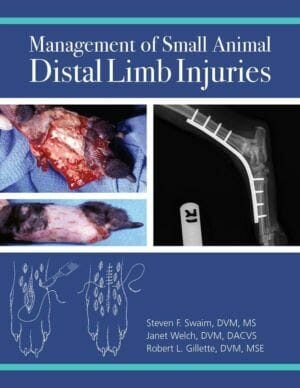Part One: Soft Tissue Injuries
Chapter 1: Initial Management of Contaminated and Infected Wounds
Preliminary Procedures
Debridement and Lavage
Wound closure Assessment
Topical Agents
Antibiotics and Antibacteriels
Wound Stimulants
Tripeptide Copper Complex
Other Topical Agents
Chapter 2: Bandages, Splints and Slings
Polyurethane Foam Sponges
Hydrogels
Collagen matrix
Nonadherent semiocclusive Pads
Adhesive Tape Stirrups
Tertiary Bandage Layer
Waterproof Adhesive Tape
Elastic Adhesive Tape-Pressure Bandage
Padding Materials
Foam Sponge Padding
Stockinette Padding
Specialty Appliances
Metal Splints
Carpal Flexion Splint
Velpeau Sling
Robinson Sling
Chapter 3: Carpal-Metacarpal/Tarsal-Metatarsal Wounds
Primary Wound Closure
Secondary Wound Closure
Peripheral Nerve Injury and Repair
Wounds With Apposed Edges – No Tension
Wounds With Apposable Edges – Tension
Various Shaped Wounds
Wounds Over The Carpus And Tarsus – Extension Surfaces
Wounds With Non Apposable Edges – Potential For Apposition And Relief of Tenstion Related
Scars
Wounds With No Potential For Apposition
Wounds With Exposed Bones And Joints
Chapter 4: Paw Wounds
Palmar/Plantar Pad Wounds – Pad Surface
Deep Abrasion Partial Avulsions And Deep Burns: Bandaging And Splinting
Pad Punctures
Metacarpal/Metatarsal Pad Loss
Pad Replacement – Phalangeal Fillet
Feline Pouch Flap
Carpal Pad – Single and Bipedicle Advancement Flaps
Pad Grafts
Feline Mesh Grafts
Superficial Interdigital (Web) Lacerations
Deep Interdigital Lacerations
Digit Orthopedic Wounds
Chapter 5: Specific Wounds – Snakebite and Psychogenic Dermatoses
Snake Bite Wounds
Psychogenic Dermatoses
Therapy
Chapter 6: Onychectomy, Deep Digital, Flexor Tenectomy and Digit Amputation
Onychectomy
Feline Deep Digital Flexor Tenectomy
Dewclaw Amputation
Digit Amputation
Part Two: Orthopedic Injuries
Chapter 7: Orthopedic Injuries of the Tarsal Area
Anatomy
Ligament and Tendon Injuries
Sprain Injury
Diagnosis and Surgical Treatment of Rupture of Both Short and Long Medial and Lateral
Collateral Ligaments
Diagnosis and Treatment of the Short Lateral Collateral Ligaments of the Tarsus
Tarsal Shearing Wounds Treated by Oen Wound Healing, Prosthetic Imbrication and Esternal
Fixation
Severe Tarsal Shearing Wounds Treated by Early Arthrodesis Using External Fixation
Severe Tarsal Shearing Wounds Treated by Delayed Arthrodesis Using Bone Plating
Plantar Intertarsal Subluxation and Luxation
Dorsal Intertarsal Subluxation
Luxation of the Base of the Talus
Tarsometatarsal Joint Subluxation
Talocalcaneal Luxation
Sprain Injury
Injury to the Common Calcaneal Tendon
Rupture or Laceration of the Common Calcaneal Tendon
Avulsion of the Gastrocnemious Tendon Insertion
Chronic Calcaneal Tendonitis
Gastrocnemious Tears at the Musculotendinous Junction Rupture of the Gastrocnemious
Muscle
Luxation of the Superficial Digital Flexor Tendon
Transarticular External Fixation of the Tarsus
Malleolar Fractures
Distal Tibial Physeal Fractures
Fractures of the Tarsal Bones
Talus Fractures
Chapter 8: Orthopedic Injuries of the Carpal Area
Anatomy
Hyperextension Injury
Collateral Ligament Instability of the Antebrachiocarpal Joint
Luxation of the Antebrachiocarpal (Radiocarpal) Joint
Milddle Carpal Subluxation
Distal Fractures of the Radius and Ulna
Distal Radial and Ulnar Fractures: Non-cominuted and Closed
Distal Radial and Ulnar Fractures: Cominuted and Open
Angular Limb Deformities
Radial Carpal Bone Fractures
Radial Carpal Bone Luxation
Accessory Carpal Bone Fractures
Soft Tissue Injury Related to the Accessory Carpal Bone
Chapter 9: Orthopedic Injuries to the Metatarsal, Metacarpal and Phalangeal Areas
Anatomy
Metacarpal and Metatarsal Fractures
Phalangeal Fractures
Ligamentous Injuries of the Phalanges
Sesamoid Fragmentation
Part Three: Atheletic and Working Dog Injuries
Chapter 10: Athletic and Working Dog Injuries
Skin Injuries
Bruised Nails
Avulsed Nails
Pad Injuries
Corns
Muscle Injuries
Interosseous Myositis or Muscle Strain
Inter osseous Muscle Tears or Ruptures
Synovial Injuries
Acute Carpal Synovitis
Chronic Carpal Synovitis
Toe Dislocations
Tendon Injuries
Palmar or Plantar Lacerations














![Ettinger’s Textbook of Veterinary Internal Medicine 9th Edition [PDF+Videos] Ettinger’s Textbook of Veterinary Internal Medicine 9th Edition [True PDF+Videos]](https://www.vet-ebooks.com/wp-content/uploads/2024/10/ettingers-textbook-of-veterinary-internal-medicine-9th-edition-100x70.jpg)

![Textbook of Veterinary Diagnostic Radiology 8th Edition [PDF+Videos+Quizzes] Thrall’s Textbook of Veterinary Diagnostic Radiology, 8th edition PDF](https://www.vet-ebooks.com/wp-content/uploads/2019/09/textbook-of-veterinary-diagnostic-radiology-8th-edition-100x70.jpg)






